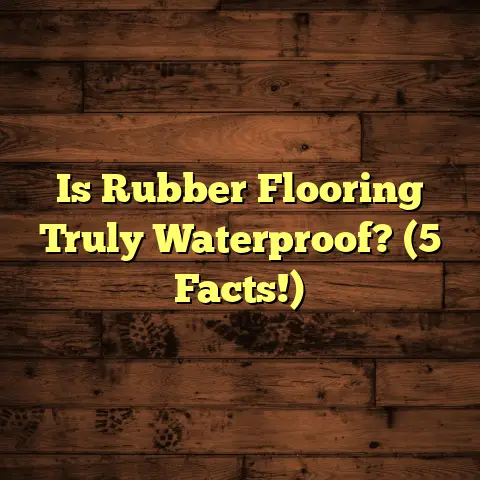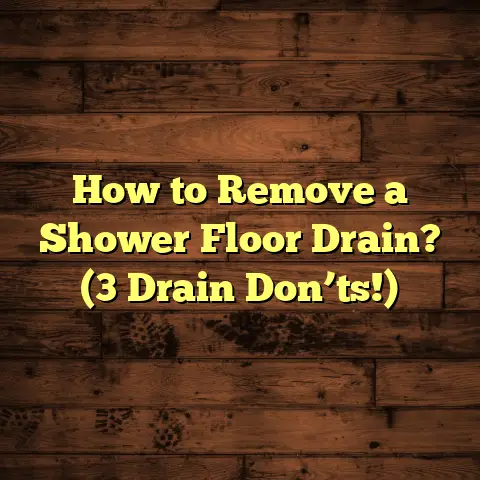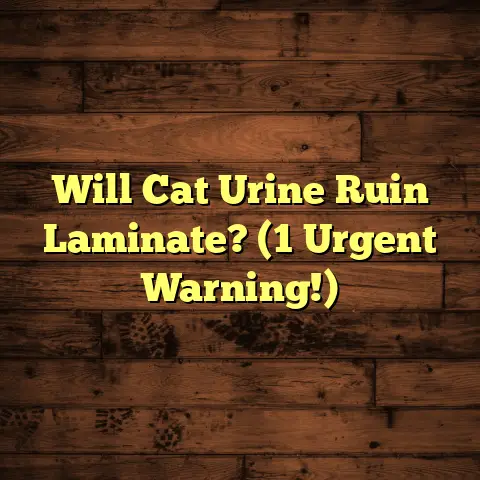Remove Paint Overspray on Hardwood? (7 Fixes NOW!)
From pet accidents to furniture scratches, and yes, even dreaded paint overspray.
Hardwood floors, am I right?
They’re stunning.
They add warmth, value, and a touch of elegance to any home.
According to the National Wood Flooring Association (NWFA), homes with hardwood floors often see a higher resale value compared to those with other flooring types.
Think about it: that rich grain, the smooth finish, the way the light dances across the surface.
It’s magic!
But like any masterpiece, hardwood requires a little TLC, especially when life throws unexpected challenges your way.
One of those challenges? Paint overspray.
Maybe you were tackling a DIY project, a little touch-up here and there, or perhaps a full-blown room renovation.
Next thing you know, tiny droplets of paint have landed on your beautiful hardwood, turning your dream into a potential nightmare.
Don’t panic! I’m here to tell you that all hope is not lost.
Over the years, I’ve developed a few tricks of the trade for dealing with this very issue.
I’m going to share with you seven unique and effective methods to remove paint overspray from your hardwood floors, so you can bring them back to their former glory.
Ready to get started? Let’s dive in!
Section 1: Understanding Paint Overspray on Hardwood Floors
Okay, let’s get down to brass tacks. What exactly is paint overspray?
Simply put, it’s those tiny, airborne droplets of paint that escape during spraying.
It happens when you’re using a spray gun or even a spray can.
These droplets can travel surprisingly far and land on surfaces you weren’t intending to paint, like your beloved hardwood floors.
Think of it like this: you’re painting a wall, and the spray isn’t perfectly contained.
The fine mist drifts, settling on nearby surfaces.
Why does this happen?
- Spray Gun Technique: Improper technique can lead to excessive overspray.
- Wind Conditions: Even a slight breeze can carry paint particles further than expected.
- Lack of Protection: Forgetting to cover floors and furniture is a common mistake.
Now, there are different types of paint, and each interacts with hardwood in its own way:
Latex Paint: This is water-based and generally easier to clean up, especially when fresh.
However, if it dries on your hardwood, it can still be a pain to remove without damaging the finish.
* Oil-Based Paint: More durable than latex, but also more stubborn to remove.Oil-based paints tend to adhere strongly to surfaces.
* Spray Paint: Often contains strong solvents that can potentially damage the finish of your hardwood if left for too long.Plus, the fine mist of spray paint makes it easy for overspray to spread.
Why is it so important to address paint overspray quickly?
Well, the longer it sits, the harder it becomes to remove.
The paint can bond with the finish of the wood, potentially causing staining or even requiring you to refinish the affected area.
According to a study by the Forest Products Laboratory, certain solvents in paints can penetrate wood finishes over time, leading to discoloration and damage.
Plus, let’s be honest, nobody wants to see tiny specks of paint all over their beautiful hardwood floors!
Section 2: Fix #1 – Using a Paint Thinner or Solvent
Alright, let’s get our hands dirty!
The first fix I often recommend involves using a paint thinner or solvent.
Now, before you reach for the strongest chemical you can find, let’s talk safety.
Safety First!
- Ventilation: This is crucial.
Open windows, turn on fans, and make sure you have plenty of fresh air circulating. - Gloves: Protect your hands from the chemicals. Wear solvent-resistant gloves.
- Eye Protection: Safety glasses or goggles will prevent any accidental splashes from getting into your eyes.
Now, here’s the technique:
- Choose Your Solvent: Mineral spirits or a paint thinner specifically designed for the type of paint you’re dealing with is best.
- Test in a Hidden Spot: Before you go all-in, find an inconspicuous area of your floor (like under a rug or in a closet) and test the solvent.
This will ensure it doesn’t damage the finish. - Apply to a Soft Cloth: Never pour the solvent directly onto the floor!
Instead, dampen a soft, clean cloth with the solvent. - Gently Rub: Work on small areas at a time.
Gently rub the affected area with the damp cloth.
Avoid applying too much pressure. - Wipe Clean: Use a separate, clean cloth to wipe away any residue.
- Repeat if Necessary: You might need to repeat the process a few times to completely remove the overspray.
Why does this work?
Paint thinners and solvents are designed to break down the chemical bonds in paint, making it easier to lift off the surface.
My personal experience:
I remember one time, I was helping a friend renovate his living room, and we got a little overzealous with the spray paint.
Overspray everywhere!
We used mineral spirits, and with a little elbow grease, we managed to get it all off without damaging his beautiful oak floors.
Section 3: Fix #2 – Rubbing Alcohol Method
Next up, we have a gentler approach: rubbing alcohol.
This is a great option if you’re dealing with latex paint overspray or if you’re concerned about using harsh chemicals.
Rubbing alcohol, or isopropyl alcohol, is a solvent that can effectively break down paint without being as aggressive as paint thinner.
Here’s how to do it:
- Gather Your Supplies: You’ll need rubbing alcohol (70% or 90% is fine), a soft, non-abrasive cloth, and a clean, dry cloth.
- Dampen the Cloth: Pour a small amount of rubbing alcohol onto the soft cloth.
Make sure the cloth is damp, not soaking wet. - Gently Dab or Rub: Gently dab or rub the affected area with the damp cloth.
Avoid scrubbing, as this could damage the finish of your floor. - Wipe Clean: Use a clean, dry cloth to wipe away any residue.
- Repeat as Needed: You may need to repeat the process several times to completely remove the paint overspray.
Important Considerations:
- Non-Abrasive Cloth: I can’t stress this enough!
Avoid using anything that could scratch your floor.
Microfiber cloths are a great choice. - Ventilation: While rubbing alcohol isn’t as strong as paint thinner, it’s still a good idea to have some ventilation.
Why does this work?
Rubbing alcohol is a solvent that can dissolve or loosen the paint particles, making them easier to wipe away.
It’s particularly effective on latex paint because latex is water-based.
A little tip from my toolbox:
I often use this method on delicate wood finishes because it’s less likely to cause damage compared to stronger solvents.
Section 4: Fix #3 – The Magic of Olive Oil and Vinegar
Now, for a truly natural and eco-friendly solution, let’s talk about olive oil and vinegar.
Yes, you read that right!
These kitchen staples can actually work wonders on paint overspray.
Why olive oil and vinegar?
Olive oil helps to soften the paint, while vinegar acts as a mild solvent to help break it down.
Plus, this method is completely safe for your family, pets, and the environment.
Here’s the recipe:
- Mix It Up: Combine equal parts olive oil and white vinegar in a small bowl.
- Apply Gently: Dip a soft cloth into the mixture and gently apply it to the paint overspray.
- Let It Sit: Allow the mixture to sit on the paint for about 10-15 minutes.
This will give the olive oil time to soften the paint. - Wipe Away: Use a clean, soft cloth to wipe away the paint.
- Repeat if Necessary: You may need to repeat the process a few times to completely remove the overspray.
Benefits of this method:
- Environmentally Friendly: No harsh chemicals involved!
- Safe for Regular Use: You can use this method as often as needed without worrying about damaging your floors.
- Gentle on Wood: Olive oil actually helps to condition the wood.
My personal experience:
I once had a client who was extremely sensitive to chemicals.
She had paint overspray on her hardwood floors, and she was hesitant to use any of the traditional methods.
I suggested the olive oil and vinegar trick, and she was amazed at how well it worked!
Not only did it remove the paint overspray, but it also left her floors looking shiny and healthy.
Section 5: Fix #4 – Commercial Paint Removers
Sometimes, you need to bring out the big guns.
Commercial paint removers can be very effective, but it’s crucial to choose the right one and use it safely.
Choosing the Right Product:
- Read the Label: Look for a paint remover that is specifically designed for use on wood surfaces.
- Check the Ingredients: Avoid products that contain harsh chemicals like methylene chloride, which can be harmful to your health and the environment.
- Consider Water-Based Options: Water-based paint removers are generally less toxic and easier to clean up than solvent-based options.
Safe and Effective Application:
- Ventilation: As with any chemical product, make sure you have good ventilation.
- Protective Gear: Wear gloves, eye protection, and a respirator if necessary.
- Test in a Hidden Area: Always test the paint remover in an inconspicuous area first to ensure it doesn’t damage the finish of your floor.
- Apply According to Instructions: Follow the manufacturer’s instructions carefully.
Apply the paint remover to the affected area and let it sit for the recommended amount of time. - Scrape Away the Paint: Use a plastic scraper to gently remove the softened paint.
Avoid using metal scrapers, as they can scratch the wood. - Clean the Area: Once you’ve removed the paint, clean the area with a damp cloth to remove any residue.
Important Note:
Always read and follow the manufacturer’s instructions carefully.
Paint removers can be dangerous if used improperly.
A word of caution:
I’ve seen homeowners get impatient and leave the paint remover on for too long, which can damage the finish of their floors.
Patience is key!
Section 6: Fix #5 – Heat Gun Technique
This method requires a bit of finesse, but it can be very effective for softening stubborn paint overspray.
How a Heat Gun Works:
A heat gun emits hot air that can soften paint, making it easier to scrape away.
However, it’s important to use it carefully to avoid damaging the wood.
Safety Tips:
- Safe Distance: Maintain a safe distance between the heat gun and the wood surface (at least 6-8 inches).
- Constant Movement: Keep the heat gun moving to avoid overheating any one area.
- Ventilation: Ensure good ventilation.
- Eye Protection: Wear safety glasses to protect your eyes from any flying paint particles.
The Process:
- Heat the Paint: Gently heat the paint overspray with the heat gun, moving it back and forth.
- Scrape Carefully: Use a plastic scraper to gently scrape away the softened paint.
- Repeat as Needed: Repeat the process until all the paint overspray is removed.
- Clean the Area: Clean the area with a damp cloth to remove any residue.
Why does this work?
The heat softens the paint, making it more pliable and easier to remove without damaging the underlying wood finish.
My personal experience:
I once used this method to remove some old, hardened paint overspray from a set of antique hardwood floors.
It took some time and patience, but the results were amazing!
Section 7: Fix #6 – Sanding the Area
Okay, let’s talk about sanding.
This should be considered a last resort, as it can potentially damage your hardwood floors if not done carefully.
When to Sand:
- Stubborn Overspray: If other methods have failed, sanding might be necessary.
- Damaged Finish: If the paint overspray has damaged the finish of your floor, sanding can help to restore it.
Choosing the Right Sandpaper Grit:
- Start Coarse: Begin with a coarser grit sandpaper (80-100 grit) to remove the paint overspray.
- Move to Finer: Gradually move to finer grits (120-150 grit, then 180-220 grit) to smooth the surface and blend it with the surrounding area.
Step-by-Step Guide:
- Prepare the Area: Clean the area thoroughly and mask off the surrounding wood to protect it.
- Sand Carefully: Use a sanding block or a palm sander to gently sand the affected area.
Avoid applying too much pressure. - Vacuum the Dust: Vacuum up all the sanding dust.
- Apply Finish: Apply a matching wood finish to the sanded area to protect it and blend it with the surrounding floor.
Important Considerations:
- Dust Control: Sanding creates a lot of dust, so wear a dust mask and use a vacuum with a HEPA filter.
- Matching the Finish: It’s crucial to match the existing finish of your floor to ensure a seamless repair.
A little tip from my toolbox:
Practice sanding on a scrap piece of wood before you tackle your hardwood floors.
This will give you a feel for the process and help you avoid making mistakes.
Section 8: Fix #7 – Professional Cleaning Services
Finally, let’s talk about hiring a professional.
Sometimes, the best solution is to leave it to the experts.
When to Call a Pro:
- Severe Overspray: If the paint overspray is extensive or difficult to remove, a professional cleaning service can save you time and hassle.
- Valuable Floors: If you have valuable or antique hardwood floors, it’s best to leave the cleaning to the professionals.
- Lack of Confidence: If you’re not comfortable tackling the project yourself, don’t hesitate to call a pro.
What to Look for in a Reputable Service:
- Experience: Look for a company with experience in cleaning and restoring hardwood floors.
- Reputation: Check online reviews and ask for references.
- Insurance: Make sure the company is properly insured.
- Clear Communication: They should be able to clearly explain their process and provide you with a detailed estimate.
Benefits of Professional Intervention:
- Expertise: Professionals have the knowledge and experience to safely and effectively remove paint overspray from your hardwood floors.
- Specialized Equipment: They have access to specialized equipment and cleaning products that are not available to the general public.
- Time Savings: Hiring a professional can save you a significant amount of time and effort.
Assessing if This Option Is Right for You:
Consider the extent of the paint overspray, the value of your floors, and your own comfort level when deciding whether to hire a professional cleaning service.
My advice:
Don’t be afraid to get multiple quotes from different companies.
This will help you find the best value for your money.
Conclusion: Restoring the Beauty of Hardwood Floors
So, there you have it: seven unique and effective methods to remove paint overspray from your hardwood floors.
Remember, addressing paint overspray promptly is key to preventing long-term damage and maintaining the beauty of your floors.
Hardwood floors bring so much character and warmth to our homes.
They’re an investment, and they deserve our care and attention.
I hope this article has given you the confidence and knowledge you need to tackle paint overspray challenges head-on.
With a little patience and the right techniques, you can restore your hardwood floors to their original glory and enjoy them for years to come.
Now, go forth and conquer that paint overspray! You got this!





